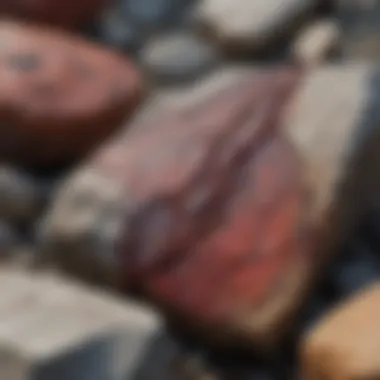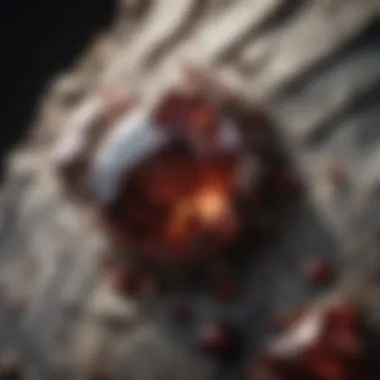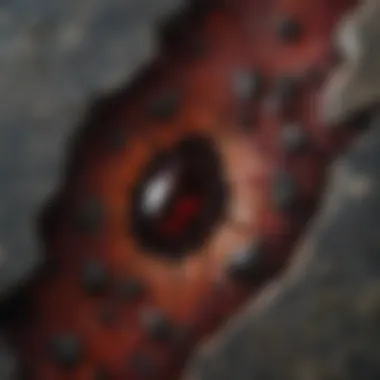Unveiling the Enigmatic Connection: Garnets and Granite


The Formation of Garnets in Granite
Garnets, illustrious gemstones renowned for their deep hues and striking beauty, are intricately intertwined with granite formations in a mesmerizing geological phenomenon. Within the depths of the Earth's crust, these gemstones are formed through intense pressure and heat, resulting in their unique crystalline structures. The inclusion of garnets in granite unveils a captivating tale of mineral formation that astounds researchers and enthusiasts alike.
The Complex Process of Garnet Inclusion
The journey of garnets within granite formations begins millions of years ago, as molten rock deep beneath the Earth's surface cools and solidifies over time. During this process, minerals such as aluminum, iron, and silica coalesce to form garnet crystals, each one a testament to the geological history embedded within granite. The intricate dance of elements and heat gives rise to these exquisite gemstones, creating a tapestry of vibrant colors and compositions within the sturdy embrace of granite.
The Significance of Garnets in Geology
Garnets within granite formations serve as a window into the Earth's ancient past, offering valuable insights into geological processes and history. Geologists rely on the presence of garnets to unravel the mysteries of tectonic movements, volcanic activities, and metamorphic transformations that have shaped our planet over eons. By studying the composition and distribution of garnets within granite, scientists can piece together the puzzle of our planet's geological evolution, unlocking secrets buried deep within the bedrock.
Exploring the Unique Relationship
The enthralling connection between garnets and granite transcends mere geological significance, delving into the realm of aesthetic beauty and cultural heritage. With their rich colors and delicate crystalline structures, garnets evoke a sense of wonder and allure that has captivated civilizations throughout history. From ancient civilizations who revered these gemstones as symbols of power and protection to modern-day enthusiasts who appreciate their beauty, garnets in granite embody a timeless allure that continues to inspire awe and admiration.
This insightful exploration into the mesmerizing presence of garnets in granite sheds light on a fascinating aspect of geology that continues to enchant and intrigue both researchers and enthusiasts. The intricate formation process, geological significance, and cultural resonance of garnets within granite formations offer a glimpse into the rich tapestry of our planet's history, inviting us to marvel at the wonders hidden beneath the surface.
Introduction
In the realm of geology and mineralogy, the enthralling interplay between garnets and granite stands as a topic of immense fascination. This article embarks on a riveting exploration of how these exquisite gemstones come to be nestled within the depths of granite formations and the profound significance they hold in the tapestry of geological wonders. By unraveling the intricate processes that govern the presence of garnets in granite, readers will embark on a journey of discovery, unearthing the nuances that define this unique relationship.
Defining Garnets and Granite
Composition of Garnets
Delving into the realm of garnets, these enigmatic gemstones are distinguished by their intricate compositions. Comprised mainly of silicate minerals, garnets boast a cubic crystal structure with a diverse range of chemical compositions. The alluring hues they display, ranging from deep reds to vibrant greens, are a testament to the varied elements that can form within their matrix. Such diversity in composition not only contributes to their striking aesthetics but also plays a crucial role in their identification and classification within the study of gemology. Moreover, the durability and hardness of garnets render them a popular choice for both ornamental and industrial applications, further solidifying their significance in the world of minerals.
Formation of Granite
A cornerstone of igneous rock formations, granite emerges through intricate processes deep within the Earth's crust. Stemming from the slow cooling of magma underground, granite undergoes a transformation marked by the crystallization of an array of minerals, including quartz, feldspar, and mica. This gradual solidification gives rise to the characteristic speckled appearance and interlocking grain structure that define granite. The durability and resilience of granite make it a sought-after material for construction and monuments, showcasing its enduring impact on both natural landscapes and human civilizations.


The Formation Process
Intrusion of Magma
Heating and Cooling
Heating and cooling play a pivotal role in the formation process by influencing the crystallization of minerals within the granite matrix. The gradual cooling of the molten magma solidifies the minerals present, including the formation of garnets. The controlled cooling process leads to the growth of structured crystal lattices, giving rise to the distinctiveness of garnets within the granite. This controlled cooling method is essential for ensuring the formation of high-quality garnets with specific characteristics, such as color and clarity, making it a preferred choice for geological enthusiasts and researchers studying these formations. By understanding the nuances of heating and cooling, one can appreciate the complexity of mineral formation within granite and the meticulous conditions required for garnet development.
Crystallization of Minerals
The crystallization of minerals within granite is a critical phase that solidifies the composition of the rock and facilitates the incorporation of garnets. As minerals cool and transition from a molten state to a solid form, the crystalline structure emerges, defining the properties of the resulting rock. In the case of garnets in granite, the crystallization process determines the size, shape, and alignment of the garnet crystals dispersed throughout the rock. This unique feature of crystallization allows for the creation of diverse garnet varieties with varying characteristics, contributing to the richness and complexity of granite formations. Understanding the intricacies of crystallization provides valuable insights into the formation of garnets within granite, shedding light on the geological processes that shape our natural landscapes.
Garnets Within Granite
In the realm of geology and mineralogy, the presence of garnets within granite holds a riveting significance that beckons exploration and understanding. As integral components of granite formations, garnets bring a dynamic element to the composition, showcasing nature's exquisite artistry. Within this article, the focus is squarely placed on dissecting the complexity and allure of garnets within granite, unraveling their intrinsic connections and implications within the geological world.
Inclusions of Garnets
Color Variations
Delving into the fascinating realm of color variations in garnets is paramount to comprehending the allure and diversity this gemstone offers within granite formations. The spectrum of colors displayed by garnets, from deep reds to vibrant greens and fiery oranges, adds a kaleidoscopic richness to granite bodies. The ability of garnets to showcase a variety of colors due to trace elements within their crystal structure sets them apart as a multifaceted gemstone coveted by collectors and jewelers alike. The interplay of light and color within garnets embedded in granite captivates observers, offering a visual feast that is both mesmerizing and enchanting. Exploring the nuances of color variations in garnets sheds light on the intricate beauty that lies beneath the surface of seemingly ordinary granite formations.
Crystal Structure
Unraveling the crystal structure of garnets nestled within granite unveils a world of meticulous design and symmetry that showcases the mineral's inherent beauty and strength. The crystal lattice of garnets imparts durability and resilience, making them a sought-after gemstone for both ornamental and industrial purposes. The distinctive cubic system of garnets imbues them with a robust nature, capable of withstanding geological pressures and maintaining their structural integrity within granite matrices. Understanding the crystal structure of garnets within granite not only unveils their geological significance but also underscores their enduring appeal and versatility in various applications. The intricate network of atoms forming the crystal lattice of garnets showcases a harmonious interplay of elements, creating a visual spectacle that resonates with aficionados of gemstones and geological wonders.
Properties and Significance
Physical Properties
Hardness
Hardness is a fundamental physical property that plays a significant role in delineating the characteristics of garnets within granite. The hardness of garnets, typically ranging from 6.5 to 7.5 on the Mohs scale, sets them apart as durable gemstones capable of withstanding everyday wear and tear. This resilience makes garnets an excellent choice for jewelry and industrial applications where durability is paramount. The unique feature of garnets' hardness lies in their ability to maintain their appearance and structure over time, making them a preferred choice in various settings. While their hardness offers exceptional durability, it also means that proper care must be taken to prevent scratches or damage.


Lustre
Lustre, another significant physical property of garnets found in granite, adds to their allure and visual appeal. The lustre of garnets refers to their ability to reflect light and create a lustrous sheen, enhancing their beauty and overall aesthetic. This characteristic makes garnets a popular choice for jewelry designers seeking to showcase vibrant colors with a captivating shine. The unique feature of lustre in garnets lies in their ability to exhibit a vitreous or resinous lustre, depending on the specific variety. While lustre enhances the visual appeal of garnets, it requires appropriate cleaning and maintenance to preserve their brilliant shine over time.
By examining the physical properties of hardness and lustre in garnets within granite, we gain a deeper understanding of their durability, aesthetic appeal, and unique characteristics that make them a cherished gemstone in various applications.
Geological Implications
In the realm of geology, the significance of the geological implications surrounding the presence of garnets in granite is profound and multi-faceted. This section delves into the in-depth analysis of how these implications contribute to our understanding of geological processes and the formation of rocks. Understanding the geological implications of garnets in granite provides valuable insights into the history and composition of terrains.
Exploring the geological implications sheds light on the evolutionary timeline of rock formations, offering clues about the ancient processes that have shaped the Earth's crust. Moreover, studying these implications aids in deciphering the environmental conditions that prevailed during the formation of these mineral combinations. By unraveling the geological implications of garnet occurrences in granite, geologists can piece together the puzzle of geological history and the movement of tectonic plates.
One key benefit of examining the geological implications lies in its ability to enhance our knowledge of the Earth's structural complexities. This analysis enables geologists to interpret the dynamics of plate tectonics and the forces that have sculpted the planet over millions of years. The geological implications of garnets in granite serve as markers of geological events, allowing researchers to reconstruct past environments and geological processes accurately.
Indicator of Tectonic Processes
Geological Mapping
Within the realm of geology, geological mapping plays a pivotal role in deciphering the intricate relationship between garnets and granite. Geological mapping involves the systematic recording of geological features on maps to visualize the distribution of rocks and minerals. This detailed mapping process aids in identifying the spatial patterns of garnet occurrences within granite formations.
The key characteristic of geological mapping lies in its ability to provide a comprehensive overview of the geological features present in a specific area. By mapping the distribution of garnets in granite, geologists can understand the structural controls and geological history associated with these mineral assemblages. Geological mapping acts as a beneficial tool for this article by offering a visual representation of how garnets are distributed within granite formations, enhancing our appreciation of their geological significance.
An advantage of geological mapping in this article is its capacity to facilitate the identification of geological structures and mineral associations within granite deposits. By meticulously documenting the spatial distribution of garnets, geological mapping enables researchers to draw meaningful conclusions regarding the formation processes and tectonic movements that have influenced the development of these rocks.
Subduction Zones
The concept of subduction zones holds a crucial position in understanding the geological implications of garnets in granite. Subduction zones are regions where one tectonic plate descends beneath another, leading to complex geological interactions and the formation of diverse rock compositions. These zones play a pivotal role in the recycling of crustal materials and the generation of magma that eventually crystallizes into granite.
A key characteristic of subduction zones is their association with intense geological activity, including volcanic eruptions and seismic events. By exploring subduction zones in the context of garnets in granite, geologists can unravel the tectonic processes that have influenced the formation and distribution of these mineral assemblages. Subduction zones offer valuable insights into the subterranean movements that have led to the emplacement of granitic rocks enriched with garnets.
The unique feature of subduction zones lies in their role as dynamic geological environments where rocks undergo significant transformations due to heat and pressure. In this article, subduction zones are elucidated as prime settings for the genesis of granite hosting garnet inclusions, showcasing the interplay between tectonic movements and mineral crystallization. While subduction zones contribute to the formation of diverse rock types, their association with garnets in granite highlights the intricate relationship between tectonics and mineralogy within the Earth's crust.


Exploring Garnet Varieties
In the realm of geological wonders lies the captivating domain of exploring garnet varieties, a topic of exquisite significance within the broader conversation of garnets in granite. Delving into the vast array of garnet types not only enriches our understanding of these gemstones but also sheds light on the diverse characteristics they possess. This section unveils the intricacies of different garnet varieties, offering insights into their distinct features and geological implications.
Almandine, Pyrope, and More
Grossular
Embark on a journey through the enigmatic world of Grossular, a distinct member of the garnet family that plays a pivotal role in our exploration of garnet varieties within granite formations. The allure of Grossular lies in its unique composition which sets it apart from other garnet types. Known for its vibrant hues ranging from luscious greens to fiery oranges, Grossular captivates enthusiasts with its rich colors that glimmer under light. Its significance in this article stems from its contribution to the vast spectrum of garnet characteristics, making it a standout choice for our comprehensive discussion. From its exceptional clarity to its remarkable dispersion of colors, Grossular showcases a fusion of elegance and durability ideal for various purposes. Exploring Grossular unveils a fascinating world of gemological possibilities, each facet reflecting the unparalleled beauty of this garnet variety.
Spessartine
Dive into the realm of Spessartine, another intriguing facet of garnet varieties that we explore within the context of garnets in granite. The allure of Spessartine stems from its unique orange to reddish-brown tones that evoke a sense of warmth and vibrancy. As we dissect Spessartine's key characteristics, we uncover its exceptional refractive index that allows light to dance and play within its depths, creating a mesmerizing display of brilliance. This garnet variety's popularity in the world of gemstones is undeniable, thanks to its fiery colors that infuse life and energy into any setting. While Spessartine radiates a distinct charm, its unique feature lies in its rarity and exclusivity, making it a prized addition to any collection. By examining Spessartine within the context of this article, we illuminate the intricate nuances of this garnet variety, offering a deeper appreciation for its true essence and allure.
Application in Jewelry and Industry
In the realm of geological wonders, the utilization of garnets in jewelry and various industries holds a prominent position. The multifaceted nature of garnets, particularly within the context of granite formations, unveils a world of possibilities for jewelry artisans and industrial applications. This section will meticulously expound upon the intrinsic value and significance of incorporating garnets in both jewelry craftsmanship and industrial practices.
Garnets as Gemstones
Cuts and Settings
Garnets, esteemed for their vibrant hues and dazzling allure, serve as captivating gemstones that beckon jewelry enthusiasts and collectors. When it comes to cuts and settings, garnets offer a myriad of options to enhance their beauty and allure. The key characteristic that sets garnets apart in cuts and settings is their exceptional clarity and mesmerizing color variations. These characteristics make garnets a popular choice for jewelry designers aiming to create stunning, eye-catching pieces. The unique feature of garnets in cuts and settings lies in their versatility, enabling artisans to craft intricate designs that highlight the gemstone's natural splendor. While garnets excel in providing a rich palette of colors, their varying hardness levels may pose challenges during cutting and setting processes, requiring skilled craftsmanship and precision techniques. Despite the intricacies involved, garnets continue to captivate admirers with their timeless elegance and extraordinary radiance.
Industrial Uses
Beyond their enchanting presence in jewelry, garnets find a compelling application in various industrial sectors, underscoring their versatility and durability. Industrial uses of garnets encompass a wide array of applications, ranging from abrasives in sandblasting to waterjet cutting and filtration systems. The key characteristic that renders garnets invaluable in industrial settings is their exceptional hardness and resistance to erosion, making them ideal for cutting and polishing hard materials. The unique feature of garnets in industrial uses lies in their ability to maintain their sharpness and integrity even under extreme pressure and abrasive conditions, ensuring optimal performance and efficiency. While garnets offer unparalleled precision and efficiency in industrial operations, their abrasive nature may require careful handling and proper safety measures to prevent health hazards. Despite these considerations, the unparalleled durability and effectiveness of garnets in industrial applications continue to position them as indispensable assets across various sectors, showcasing their enduring legacy in the industrial landscape.
Conclusion
Reflecting on Nature's Marvels
Diversity of Geological Wonders
Discussing the diversity of geological wonders within the context of garnets in granite unveils a realm of remarkable variations and phenomena. The geological wonders encapsulated within garnets and granite formations offer a kaleidoscopic array of colors, structures, and compositions, depicting the rich tapestry of Earth's history. This diversity not only showcases the vast spectrum of possibilities in mineral formations but also underscores the intricate processes that have shaped these geological treasures over millennia. Delving into the nuances of geological diversity provides invaluable insights into the complex interplay of elements and forces that have sculpted the landscapes we see today.
Intricacies of Mineral Formation
Exploring the intricacies of mineral formation sheds light on the meticulous craftsmanship of nature in crafting each garnet within granite. The precise conditions required for garnet growth, including temperature, pressure, and mineral composition, illustrate the delicate balance of factors necessary for these gemstones to form. The interplay of various geological processes such as metamorphism, magmatism, and mineral precipitation unravels the intricate tapestry of mineral formation within granite, giving rise to diverse crystal structures and color variations. Understanding the intricacies of mineral formation not only enriches our knowledge of Earth's geological history but also deepens our appreciation for the complex mechanisms underlying the formation of garnets within the matrix of granite.







